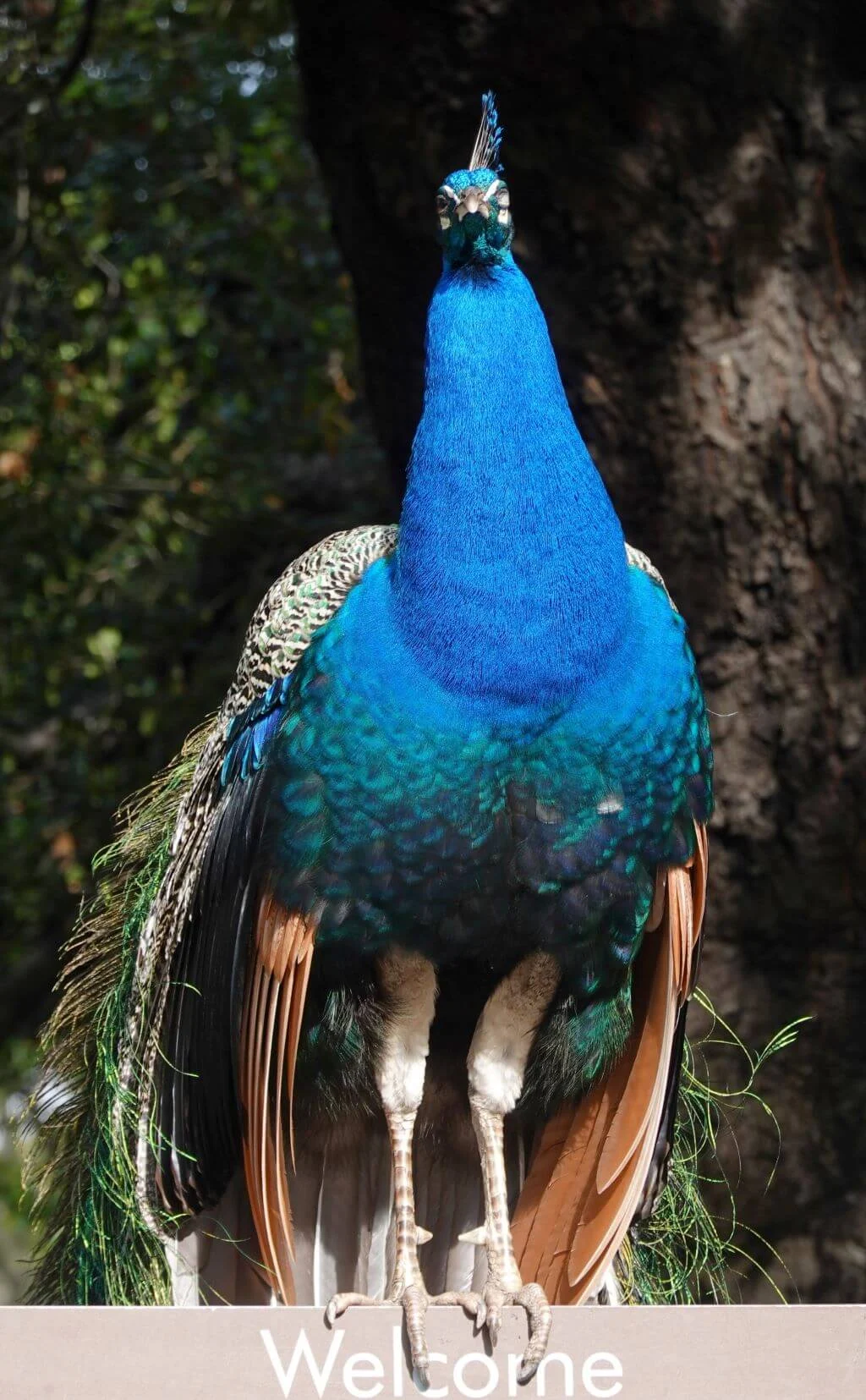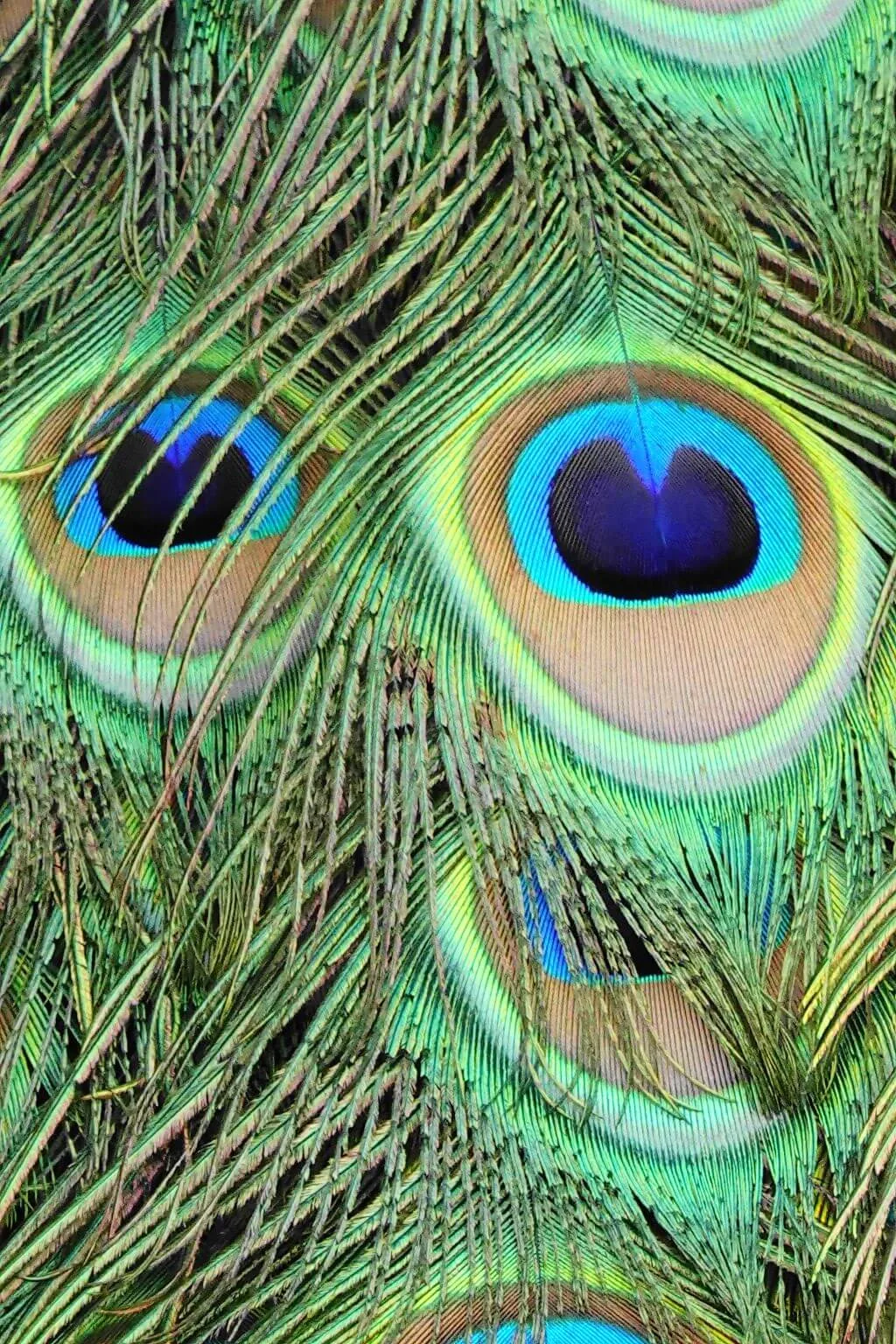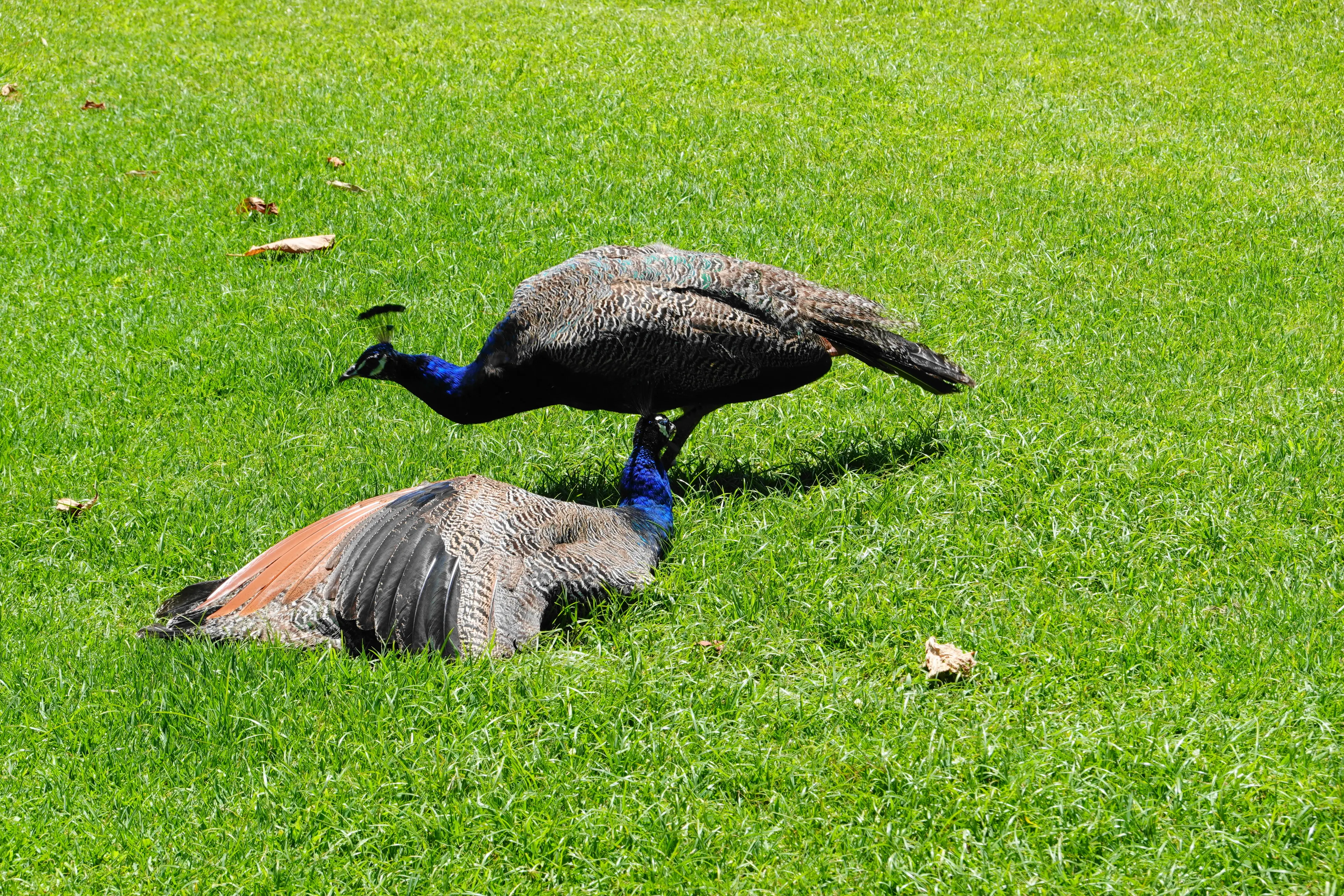It is hard to imagine that wild peafowls are often seen roaming in the Los Angeles Arboretum. The Chinese often call it the Peacock Garden. During the breeding period, it is very interesting to see the male peacocks spread and shake their beautiful long feather trains, singing loudly to attract the attention of the female peahens. Peafowls are the largest members of the pheasant family. There are two popular Asiatic peafowl species: Indian or blue peafowl (from India, Sri Lanka) and green peafowl (from Java, Myanmar(Burma). Plus a less popular species: Congo peafowl (from Africa). Sexual dimorphism is observed between the male peacock and the female peahen. The biggest notable distinction between the two is the tail feathers possessed by the male, commonly referred to as a “train”. The plumage of the male plays several vital roles. Not only does it help attract a mate, but it also serves to intimidate predators and rivals for mating. In courtship, vocalization also is a way for peacocks to attract peahens. Peafowls are believed to be polygamous. They are social and live in groups. Peafowls are omnivores. They nest on the ground, but roost in trees. To Hindus, the peafowl is a sacred bird; the spots on the peacock’s train symbolize the eyes of the gods. In 1963, India adopted it as its national bird. I saw a special peacock video on IG and would like to share it here.
很難想像洛杉磯的植物園中常看到野生的孔雀漫步在園中,華人常稱它為孔雀園。在繁殖期間就看到那一隻隻的公孔雀很奮力的伸展並抖動它們漂亮的長尾覆羽,大聲嚷嚷想吸引母雀的注意力,非常有意思。孔雀是雉科中最大的成員。有兩種廣受喜愛的亞洲孔雀物種:印度孔雀或藍孔雀(來自印度、斯里蘭卡)以及綠孔雀(來自爪哇、緬甸)。還有一個不太知名的物種:剛果孔雀(來自非洲)。孔雀有明顯的雌雄兩性的不同性徵,最主要雄孔雀有會開屏的長尾覆羽,而雌孔雀沒有。雄性的羽毛有著幾個重要的作用,它不僅有助於吸引配偶,還可以恐嚇捕食者和交配對手。在求愛時,發聲也是雄孔雀吸引雌孔雀的一種方式。人們認為孔雀是一夫多妻制的。它們是群居過群體生活。孔雀是雜食動物。在地面上築巢,但棲息在樹上。對印度教徒來說孔雀是很神聖的,它羽毛上的斑點像徵著眾神的眼睛。1963年印度將其定為國鳥。我在 IG 上看到一則好奇特的孔雀影片,在此分享做記錄。









When a peacock wants to woo a peahen, he unfurls his glorious, iridescent feathers and furiously vibrates them in what’s called a “train-rattling” display. Peahens are believed to choose their mates according to the size, color, and quality of those outrageous feather trains. But the drab color of the peahens helps them to camouflage while they are sitting on eggs. Peahen lays a clutch of three to eight light green or tan eggs. Peahen usually raises her peachicks on her own.
當公孔雀想要向母孔雀求愛時,它會展開絢麗的彩虹色羽毛,並劇烈振動它們,形成所謂的“覆羽嘎嘎聲”展示。據說母孔雀通常是依公雀羽毛的大小、顏色及品質來選它的伴。而母雀身上單調的顏色則有助於它們僞裝隱藏自己,在孵蛋時比較安全。母雀一胎生三到八個淺綠或褐色的蛋。母雀通常獨自撫育幼雀。






Peacocks finish shaking their tail feathers and their stunning plumage gradually falls off toward the end of summer every year. This shedding process is called molting. In about seven months – in time for the peafowl mating season to come back around – peacocks will regrow their plumes longer and fuller. The peacock's tail reaches peak development around age 6. Because of the size boost from the feathers, peacocks are one of the largest flying birds.
每年夏末,孔雀尾羽結束擺動,美麗的羽毛逐漸脫落,這種脫落過程稱為蛻皮。大約七個月後 (孔雀交配季節即將到來) 孔雀的羽毛會重新長得更長、更豐滿。孔雀的尾巴在六歲時達到發育的高峰。由於羽毛增大,孔雀成為最大的飛鳥之一。


If there is a peafowl kingdom, I think it would look like the pictures below at the Los Angeles Arboretum. Poetic!
如果有孔雀王國的話,我想就像在洛杉磯植物園的這個樣子如詩如畫。





Notes 筆記
- Peafowl are the largest members of the pheasant family. Male peafowl are referred to as peacocks, and female peafowl are referred to as peahens, and babies are referred to as peachicks.
- There are two popular Asiatic peafowl species: Indian or blue peafowl (from India, Sri Lanka) and green peafowl (from Java, Myanmar(Burma)). Plus a less popular species: Congo peafowl (from Africa).
- Sexual dimorphism is observed between the peacock and the peahen. The biggest notable distinction between the two is the tail feathers possessed by the male, commonly referred to as a “train”. These consist of tail quill feathers and highly elongated upper tail coverts, marked with eyespots. This is most commonly seen when a peacock fans his tail. The Indian peacock (Pavo cristatus) has iridescent blue and green plumage. The Indian peahen has a mixture of dull grey, brown, and green in her plumage. Male green peafowl (Pavo muticus) have green and bronze or gold plumage, and black wings with a sheen of blue. The green peahen is similar to the male, but has shorter upper tail coverts, a more coppery neck, and overall less iridescence.
- The plumage of the male plays several vital roles. Not only does it help attract a mate, but it also serves to intimidate predators and rivals for mating. One key feature of the train of feathers present in the peacock is that they are easily detachable. So if a predator grabs it by its tail feathers, it can escape and fly away. In the case of the peahens, their more muted green coloration allows them to blend into greenery such as bushes and shrubs. This camouflages her against predators. The female also displays her plumage to ward off female competition or signal danger to her young.
- Peafowl are omnivores and mostly eat plants, flower petals, seeds, insects and other arthropods, reptiles, and amphibians.
- Peafowl are forest birds that nest on the ground, but roost in trees. They are terrestrial feeders. Peafowls have 4 toes on each foot, 3 pointing forward and 1 pointing backward. This helps them to grab onto branches and roost in trees. Peafowl are among the heaviest of flying birds, although they prefer walking and running to flying.
- All species of peafowl are believed to be polygamous. They are social and live in groups. These groups are generally harems consisting of a single male peacock and several peahens. Males are fiercely territorial when it comes to other birds and even competing peacocks, aggressively attacking those entering their territory.
- In courtship, vocalization stands to be a primary way for peacocks to attract peahens. Some studies suggest that the intricacy of the "song" produced by displaying peacocks proved to be impressive to peafowl. Singing in peacocks usually occurs just before, just after, or sometimes during copulation. Peafowl have 11 different calls which are not pleasant to humans. Peacocks call practically all day during the breeding season.
- The peacock has played a major role in Indian culture and history. The Hindu god of war Kartikeya rides one as a mount and the Buddhist deity Mahama Yuri is often depicted seated on one. In 1963, India adopted it as its national bird. To Hindus, the peafowl is a sacred bird; the spots on the peacock’s train symbolize the eyes of the gods.
- In Greek mythology, the goddess Hera took the eyes of the fallen hundred-eyed monster Argus, who watched over her while she was shape-shifted into a cow, and preserved them as the tail feathers of the peacock. Ancient Greeks believed that the flesh of peafowl did not decay after death, so it became a symbol of immortality.
- Peacocks are mentioned in the Bible (1 Kings 10:22) as one of the most precious items brought by King Solomon’s ships.
- The 'eyes' in the peacock's tail feathers symbolize the all-seeing Christian God and – in some interpretations – the Church. A peacock drinking from a vase is used as a symbol of a Christian believer drinking from the waters of eternal life. The peacock can also symbolize the cosmos if one interprets its tail with its many 'eyes' as the vault of heaven dotted by the sun, moon, and stars. By Christian adoption of old Persian and Babylonian symbolism, in which the peacock was associated with Paradise and the Tree of Life, the bird is again associated with immortality. In Christian iconography, the peacock is often depicted next to the Tree of Life.
- Among Ashkenazi Jews, the golden peacock is a symbol for joy and creativity, with quills from the bird's feathers being a metaphor for a writer's inspiration.
- Peafowl was often served as a delicacy in ancient civilizations such as Rome and medieval Europe.
- 孔雀是雉科中最大的成員。在古漢語中,孔雀又寫作孔爵,或稱為孔鳥、越鳥、南客。孔雀的形象被認為是中國古代傳說中的神鳥鳳凰的原型。
- 有兩種廣受喜愛的亞洲孔雀物種:印度孔雀或藍孔雀(來自印度、斯里蘭卡)以及綠孔雀(來自爪哇、緬甸)。還有一個不太知名的物種:剛果孔雀(來自非洲)。
- 孔雀有明顯的雌雄兩性的不同性徵。兩者之間最顯著的區別是雄性長的尾上覆羽,通常被稱為“尾羽”,它們由尾羽和拉長的上尾羽組成,上面有眼點,當孔雀扇動尾巴時,便會見到。印度雄孔雀(Pavo cristatus)有色彩斑斕的藍色和綠色羽毛。印度雌孔雀的羽毛是混合了暗灰色、棕色和綠色。雄性綠孔雀(Pavo muticus)有綠色和青銅色或金色的羽毛,黑色的翅膀帶有藍色的光澤。雌綠孔雀與雄孔雀相似,但上尾羽較短,頸部顏色較銅色,色彩較不燦爛。
- 雄性的羽毛起著幾個重要的作用。它不僅有助於吸引配偶,還可以恐嚇捕食者和交配對手。孔雀羽毛的一個關鍵特徵是它們很容易脫落。因此如果捕食者抓住它的尾羽,它就可以逃脫並飛走。就雌孔雀而言,它們不耀眼的綠色,使它們能夠融入灌木叢等綠色植物中,讓它能夠偽裝自己以抵禦掠食者,它也會展示自己的羽毛來抵禦其它雌性的競爭或向幼孔雀發出危險信號。
- 孔雀是雜食動物,主要吃植物、花瓣、種子、昆蟲和其他節肢動物、爬行動物和兩棲動物。
- 孔雀是森林鳥類,在地面上築巢,但棲息在樹上。它們是陸棲的進食者。孔雀的每一隻腳有四根腳趾頭,三根向前一根向後,這有助於它們抓住樹枝棲息在樹上。孔雀是最重的飛鳥之一,但它們更喜歡步行和奔跑而不是飛行。
- 所有種類的孔雀都被認為是一夫多妻制的。它們是群居的,這些群體通常是由一隻雄性孔雀和幾隻性雌孔雀組成。當涉及到其他鳥類,甚至是競爭的孔雀時,雄性會強烈地攻擊那些進入其領地的鳥。
- 在求偶過程中,發聲是雄孔雀吸引雌孔雀的主要方式。一些研究發現雄孔雀所發出的複雜的“歌聲”給䧳孔雀留下了深刻的印象。雄孔雀的鳴叫通常發生在交配前、交配後或有時發生在交配期間。孔雀有11種叫聲,對人來說這些叫聲都很難聽。公雀在交配季節是成天在叫。
- 孔雀在印度文化和歷史中扮演了重要角色。印度教戰神卡爾提凱亞(Kartikeya)騎著它當成一匹坐騎,而佛教神祇摩訶瑪尤里(Mahama Yuri)也經常被描繪成坐在孔雀上當坐騎。1963年印度將其定為國鳥。對印度教徒來說孔雀是很神聖的,它羽毛上的斑點像徵著眾神的眼睛。
- 希臘神話中,女神赫拉在她變成一頭牛時,取走了百眼怪物阿古斯的眼睛,並將其保存為孔雀的尾羽。古希臘人相信孔雀死後肉不會腐爛,因此成為不朽的象徵。
- 聖經中的列王紀上1:20提到孔雀是所羅門王從外邦海運來的寳物之ㄧ。
- 孔雀尾羽中的“眼睛”象徵著無所不能的基督教上帝,在某些解釋中還像徵著教會。孔雀從花瓶裡喝水被用作象徵基督教信徒飲用永生之水。如果人們將孔雀的尾巴與許多“眼睛”解釋為星羅棋布的太陽、月亮和星星的天空,那麼孔雀也可以像徵宇宙。基督教採用了古老的波斯和巴比倫象徵主義,其中孔雀與天堂和生命樹聯在一起,孔雀再次與不朽聯在一起。在基督教圖像學中,孔雀經常被畫在生命樹旁邊。
- 在德系猶太人中,金孔雀是歡樂和創造力的象徵,孔雀的羽毛隱喻著作家的靈感。
- 在羅馬和中世紀歐洲等古代文明中,孔雀經常拿來當美味佳餚。
References 參考資料
- Wikipedia: Peafowl
- Animal Spot: Peacock
- How stuff works: If a Peacock Loses His Tail Feathers, Do They Grow Back?
- 維基百科: 孔雀
Birds Posts 鳥的帖子
Comments